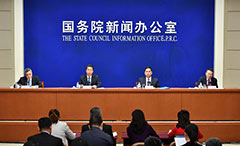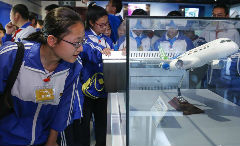Report hails ‘steady rise’ in rights protection sector
2017-06-15
China Daily
The State Intellectual Property Office released its annual comprehensive report in Beijing on June 12, covering the latest IP developments in China.
The report analyzes domestic trends in IP creation, utilization and protection between 2010 and 2016.
China has experienced a “steady rise” in comprehensive IP development over the past seven years, said Han Xiucheng, director of SIPO’s Intellectual Property Development and Research Center-which was tasked with compiling the annual report-at a news conference.
Multiple indicators were factored into the research, including invention quantity, quality and efficiency, utilization scale and market value, judicial and administrative protection, and IP management systems, services and awareness.
Government data show that SIPO received nearly 1.34 million applications for invention patents in 2016, a 21.5 percent increase from a year earlier, enabling China to retain its spot at the top of the world rankings for six consecutive years. International filings via the Patent Cooperation Treaty surged nearly 50 percent to 41,000 last year.
Annual trademark applications surpassed 3.69 million in China last year, up 28.4 percent year-on-year, more than any other country for 15 consecutive years. More than 3,000 international filings through the Madrid System for the International Registration of Marks were from China in 2016, an increase of 29.8 percent from 2015.
Copyright registrations grew 22.3 percent to roughly 2 million, and more than 2,000 new plant varieties were registered in 2016, a 35.2 percent rise.
“The central government has made innovation central to the country’s development and local authorities have rolled out a great number of policies to encourage innovation and startups,” Han said.
Along with the growth in filings and registrations, the report also found a marked improvement in IP quality, he noted.
Applications for invention patents, which have more stringent requirements for patent-ability than the other two types-utility models and industrial designs-accounted for 36.37 percent of total annual filings in 2016. The proportion was 25.96 percent in 2010.
The average validity period of invention patents grew to 5.88 years in 2016 from 5.64 years in 2010.
“Generally, the longer the period is, the higher the patent quality is,” Han said. “Only for those that are really high-quality and worth investments are patentees willing to spend on maintaining their validity.
“The government needs to place an emphasis on promoting an improvement in IP creation quality and its market value,” he said.
Zhang Zhicheng, deputy director of the center, said: “To improve IP quality is a complex, systematic issue.”
Improvement will involve the joint efforts of various stakeholders at all levels, high-quality inventions, professional documentation by agencies, efficiency in filings’ processing, market performance, legal and administrative protection and public awareness, Zhang added.
The stockpiling of creations has brought about a boom in the IP market.
More than 3,600 patent-collateralized loans worth 43.3 billion yuan ($6.37 billion) were issued by financial institutions nationwide in 2016.
Nearly 137,900 patents and rights to filings were transferred in 2016-an increase of 54.8 percent compared with a year earlier-while total annual licensing fees dropped slightly to $23.1 billion.
Trademark-collateralized loans increased 20 percent to 65 billion yuan last year.
Guangdong province, again, topped all 31 provinces, municipalities and autonomous regions on the Chinese mainland in terms of its IP comprehensive development index, a measure created in the report.
Beijing took second place and Shanghai ranked No 3 in the ranking, followed by Zhejiang and Jiangsu provinces.
The report also featured international comparisons among Singapore, 34 members of the Organization for Economic Cooperation and Development and the emerging economies of Brazil, Russia, India and South Africa.
The countries together contributed more than 98 percent of global research and development expenditures and approximately 89 percent of invention patent filings worldwide. Their combined GDP accounted for roughly 88 percent of the world’s total.
Han’s team conducted research into IP creation, utilization, protection, management, domestic innovations’ contributions, international influence, systems, markets and culture in the countries from 2011 to 2015 to evaluate their IP capacity, performance and environment.
China raised its position in the world ranking from No 19 in 2012 to No 10 in 2015, while the United States, Japan, South Korea and Germany remained in the top four.
The report is designed to reflect differences among the respective local economies and provide references for policymakers, Han said.
“China is increasingly approaching its goal of building itself into a strong IP powerhouse,” Han said. “The key to the goal is how many core technologies and well-established brands we have and how much our innovation capacities can improve.”


